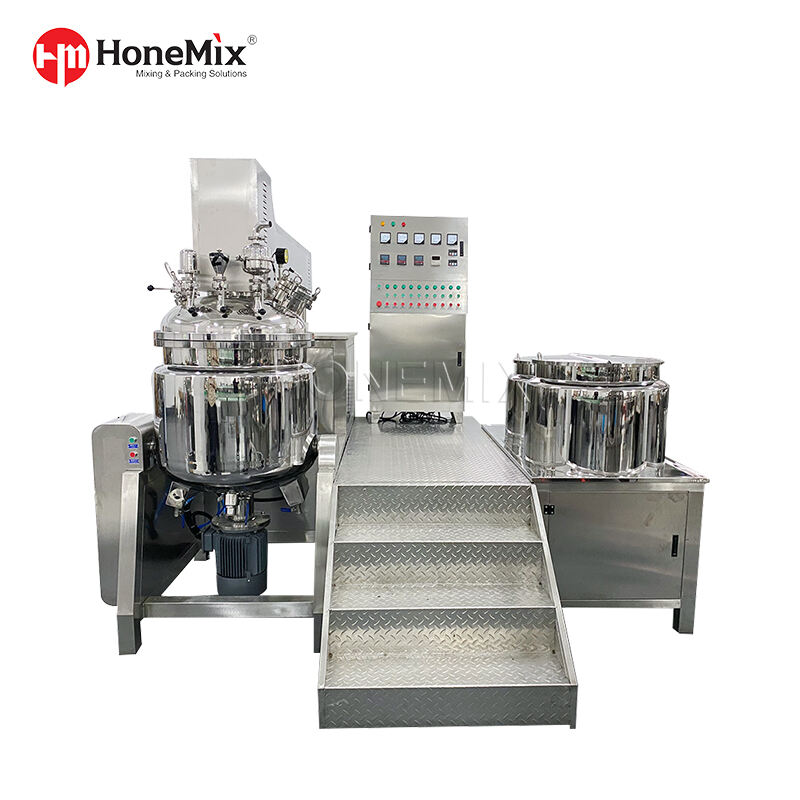The Role of The Vacuum Emulsifying Mixer in the Industrial ProcessVacuum emulsifiers are indispensable for today's industrial process where it lends invaluable support to the manufacture products ranging from creams and lotions, sauces to pharmaceuticals. These mixers are specially designed for producing entirely homogeneous blends as emulsifiers, surfactants and a variety of other ingredients often form combinations. Here will be laid emphasis on the science behind Vacuum Emulsifying Mixers and how it operates.
What Does A High-Speed Rotor Do In Case Of Vacuum Emulsifier?
This high-frequency rotational shear force around the central axis is created to cut, mix and disperse the materials quickly. It breaks down particals of every ingredient and also determines how fine your final smooth texture is going to be. In the last post I addressed wearing out your impact mill, but how does one choose a rotor for an application?
In order to achieve the best results it may be necessary for rotor tip speeds fast enough to generate a strong shearing force sufficient fora good breaking down of ingredient. Also, the design of rotor matter to have an evened-out final mix as well. If a rotor is not balanced correctly, machine vibrations can reduce the effectiveness of any mixer and influence its output quality.
Smooth blends from a Vacuum Emulsifying Mixer
The vacuum emulsifying mixers work due to the interaction and harmonizing of three key elements: pressure, temperature and mechanical action. It has components of mechanical advantage that function collectively to grind the ingredients and comprehend it into smaller particles, emulsify them so they are fully bonded with each other across their breadth.
One of those vital conditions is the pressure in a mixing chamber. It is due to the vacuum provided by a Vacuum emulsifying mixer which allows all air and gas bubbles can be sucked out of it. Otherwise air pockets or bubbles accompany what will be inhomogeneous texture/consistency.
Temperature also demonstrated a major effect in relation to mixing viscosity and ingredient compatibility. Like the lower viscosity, warmer temperatures are at least partially responsible for how much easier it is to combine. More importantly, some products such as cosmetics or food could suffer quality loss when they are exposed to higher temperatures.
How Does Pressure and Temperature Affect Vacuum Emulsifying Mixer?
At any kind of the high speed, pressure or temperature unit for itself in a vacuum emulsify mixer will have accumulated economic effect. The high-speed rotor exerts a grinding action to powder the components so that they may be easily powdered into smaller particles. The pressure inside the chamber ensures even ingredient blending and temperature control also lowers viscosity to assist with mixing.
The benefit of vacuum emulsifying mixers It's also very good for temperature-sensitive products, such as proteins and natural ingredients are concerned about heat damage problems because the combination of low temperatures at high pressure can help to reduce those concerns That is specifically why vacuum emulsifying mixers look to turn into so useful within this instance
Article at Adeep Dive into Fluid Dynamics
This is one of the highlights where fluid dynamics comes into play in creating a scientific base for vacuum emulsifying mixers. This is important given the level of details in the dynamics of fluids at this stage which fuel a gentle and homogenous mixing. A high-speed rotor generates shearing forces releasing a suite of fluid dynamics phenomena such as turbulence, cavitation or shear stress.
Turbulence: when the motion of a fluid is so intense it has chaotic and random motions. Cavitation however, is the formation of small air pockets or bubbles in a fluid due to low pressure. The high-speed rotor can also cause cavitation which creates shearing forces that help further crush any remaining particles in the blend.
Shear stress:Frictional forces between parts of material experiencing differential motion; e.g. when layers slide relative to each other in fluids, the force of friction is proportional to how fast these streaks or bands spread apart (resistance against flowing) and they cause streaking along planes where fluid moves faster/slower..." Also, in accordingly with the shear stress, a further understanding enables optimizing of rotor speed and viscosity in order to get resultant materials level equally.
Know The Science behind Vacuum Emulsifying Mixer Homogenizing
At the end is Homogonization, it's core and frontiers in all process by the vacuum emulsifying mixer. This is the conversion of particles iof liquid and solid in a micture into an optimum size and it consists of breaking them to even smaller pieces. This homogenization step must be attained not only for the production of creams or pharmaceuticals but even with food preparation.
Homogenization is the operation of high-speed rotor in a vacuum emulsifying mixer causing particles to shatter. The more rapidly rotating one with shearing and grinding elements that give you shear and mixing forces to break particles down smaller is high-speed shear/grinding type coil. Something can be done regarding this process by increasing rotor speed progressively or reversal of rotation direction for mixer.
In summary, based on the scientific principle of a vacuum emulsifying mixer we can make good quality creamy & homogenous products. The performance of vacuum emulsifying mixers depends on factors such as pressure, temperature and mechanical action and so forth working in the homogenization stage through which a product quickly passes. That provides blender operators with a good feel for how to scale in order to achieve the texture, viscosity and quality level desired in their final product.

 EN
EN
 AR
AR
 BG
BG
 HR
HR
 CS
CS
 DA
DA
 NL
NL
 FI
FI
 FR
FR
 DE
DE
 EL
EL
 IT
IT
 JA
JA
 KO
KO
 NO
NO
 PL
PL
 PT
PT
 RO
RO
 RU
RU
 ES
ES
 SV
SV
 TL
TL
 ID
ID
 LV
LV
 LT
LT
 SR
SR
 SL
SL
 VI
VI
 SQ
SQ
 HU
HU
 TH
TH
 TR
TR
 FA
FA
 MS
MS
 GA
GA
 BE
BE
 HY
HY
 BN
BN
 KK
KK
 UZ
UZ

